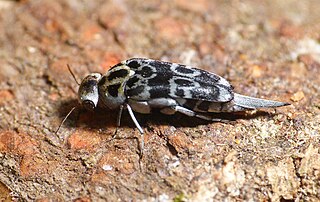
Sharks are a group of elasmobranch fish characterized by a cartilaginous skeleton, five to seven gill slits on the sides of the head, and pectoral fins that are not fused to the head. Modern sharks are classified within the clade Selachimorpha and are the sister group to the Batoidea. Some sources extend the term "shark" as an informal category including extinct members of Chondrichthyes with a shark-like morphology, such as hybodonts. Shark-like chondrichthyans such as Cladoselache and Doliodus first appeared in the Devonian Period, though some fossilized chondrichthyan-like scales are as old as the Late Ordovician. The earliest confirmed modern sharks (selachimorphs) are known from the Early Jurassic around 200 million years ago, with the oldest known member being Agaleus, though records of true sharks may extend back as far as the Permian.
Piratisca is a genus of moths of the family Noctuidae. The genus was erected by Edward Meyrick in 1902. Both species in this genus are known from New Guinea.

Seashore wildlife habitats exist from the Tropics to the Arctic and Antarctic. Seashores and beaches provide varied habitats in different parts of the world, and even within the same beach. Phytoplankton is at the bottom of some food chains, while zooplankton and other organisms eat phytoplankton. Kelp is also autotrophic and at the bottom of many food chains. Coastal areas are stressed through rapid changes, for example due to tides.

Lottia subrugosa is a species of sea snail, a true limpet, a marine gastropod mollusk in the family Lottiidae. It is still designated under its synonyms Acmaea subrugosa or Collisella subrugosa in many textbooks.

Axis is a genus of deer occurring in South and Southeast Asia. As presently defined by most authorities, four species are placed in the genus. Three of the four species are called hog deer. The genus name is a word mentioned in Pliny the Elder's Natural History.

Glipa is a genus of beetles in the family Mordellidae, containing the following species:
Glipa rufotincta is a species of beetle in the genus Glipa. It was described in 1917.

iNaturalist is an American 501(c)(3) nonprofit social network of naturalists, citizen scientists, and biologists built on the concept of mapping and sharing observations of biodiversity across the globe. iNaturalist may be accessed via its website or from its mobile applications. iNaturalist includes an automated species identification tool, and users further assist each other in identifying organisms from photographs. As of 9 July 2024, iNaturalist users had contributed approximately 197,660,888 observations of plants, animals, fungi, and other organisms worldwide, and 290,007 users were active in the previous 30 days.

Indothais is a genus of sea snails, marine gastropod mollusks, in the family Muricidae, the murex snails or rock snails.

Thaisella is a genus of sea snails, marine gastropod mollusks, in the family Muricidae, the murex snails or rock snails.

Indothais rufotincta is a species of sea snail, a marine gastropod mollusk, in the family Muricidae, the murex snails or rock snails.
Animal Ethics is a nonprofit organization formed to promote discussion and debate around issues in animal ethics and to provide information and resources for animal advocates. They also do outreach work in several countries on the issue of speciesism. Their aim is to create a world where moral consideration is extended to all sentient beings. The organization's website covers topics such as speciesism, sentience, veganism and wild animal suffering and has content translated into several languages.

Tetraclita is a genus of sessile barnacles in the family Tetraclitidae. There are more than 20 described species in Tetraclita.

Tetraclitidae is a family of sessile barnacles in the order Balanomorpha. There are about 10 genera and more than 50 described species in Tetraclitidae.

Tetraclita rubescens, commonly known as the pink volcano barnacle, is a species of sessile barnacle in the family Tetraclitidae.

Tetraclita serrata, the grey volcano barnacle, is a species of symmetrical sessile barnacle in the family Tetraclitidae. It is found in Africa.

Tetraclita squamosa, the green volcano barnacle, is a species of symmetrical sessile barnacle in the family Tetraclitidae.

Tetraclita stalactifera, the ribbed barnacle, is a species of symmetrical sessile barnacle in the family Tetraclitidae. It is found in the western Atlantic Ocean.

Tetraclita japonica, the Japanese volcano barnacle, Kurofujitsubo, is a species of symmetrical sessile barnacle in the family Tetraclitidae.















